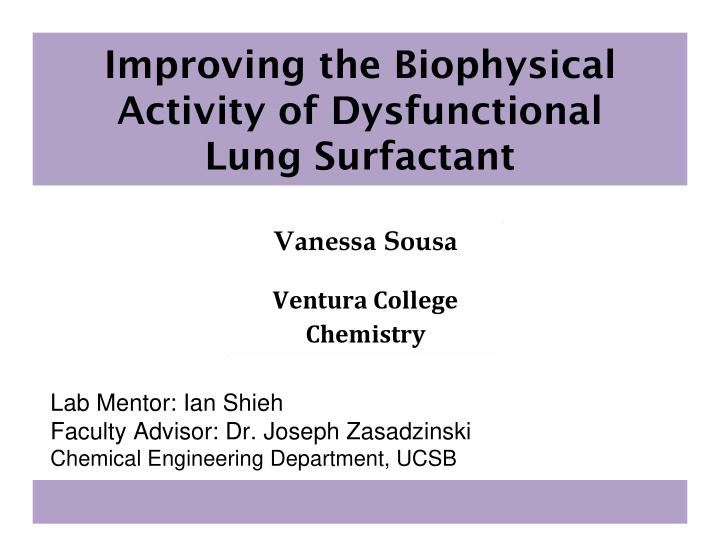



Improving the Biophysical Activity of Dysfunctional Lung Surfactant Vanessa Sousa Ventura College Chemistry Lab Mentor: Ian Shieh Faculty Advisor: Dr. Joseph Zasadzinski Chemical Engineering Department, UCSB
Lung Surfactant & ARDS • What is Lung Surfactant? – Lowers Surface Tension in Lungs Air • Acute Respiratory Distress Syndrome (ARDS) Surfactant – Surfactant Deactivation – In the U.S., 150,000 cases/year, 40% mortality rate Liquid • Reversal of Surfactant Deactivation Notter, R.H., ed. Lung Surfactants: Basic Science and Clinical Applications. 1 ed. Lung Biology in Health and Disease, ed. C. Lenfant. Vol. 149. 2000, Marcel Dekker, Inc.: New York, N.Y. 444. http://www.lawsonresearch.com/v1.0/website/lung/images/lungs_1.jpg http://services.epnet.com/GetImage.aspx/getImage.aspx?ImageIID=2547 http://www.scitech.ac.uk/PandS/Gallery/ISISbeauty/ISISlbf0004.jpg
Albumin & Competitive Adsorption • Lung Surfactant Meets Albumin – Main Protein in Blood Serum Interface Albumin Albumin Albumin • Competitive Adsorption – Albumin Blocks Lung Surfactant from Interface Surfactant Subphase (Liquid) Aggregates
Langmuir Trough • Our Model of the Human Lung Thermometer – Expansion & Compression of Barriers Surface Pressure Sensor Metal Barriers
Modeling Lung Behavior • The Healthy Lung Metal Barriers – Survanta (Lung Surfactant) – Rapid Adsorption • ARDS – Albumin – Surfactant Inhibition • Reversing ARDS with Polyethylene glycol (PEG) – Hydrophilic Polymer – Shown to enable re ‐ adsorption Saline Solution
Confocal Microscopy • Simultaneous Multiple Imaging – Fluorescently View & Track Three Molecules at the Same Time Lung Surfactant Albumin PEG • Optical Sectioning Capability Air – Image Slices Taken at Z (µm) Interface Various Depths Subphase (Liquid)
Surface Pressure vs. Area • Unique Shapes – Tells Type of Molecule at Surface Pressure (mN/m) Surface Pressure (mN/m) Surface Pressure (mN/m) 70 70 70 Albumin Only Albumin Only Interface Albumin & Survanta Albumin & Survanta 60 60 60 Albumin,Survanta,& PEG Albumin Only • Surface Pressure 50 50 50 in Saline Soln. – High Surface Pressure = 40 40 40 Low Surface Tension – Can Evaluate Effectiveness 30 30 30 of Surfactant at Interface 20 20 20 • Our Models 10 10 10 – The Healthy Lung 0 0 0 – Albumin 30 40 50 60 70 80 90 100 30 40 50 60 70 80 90 100 30 40 50 60 70 80 90 100 – Lung Surfactant Inhibition Trough Area (%) Trough Area (%) Trough Area (%) – PEG Reversal of Inhibition
Intensity Profiles Normalized Fluorescence Intensity Normalized Fluorescence Intensity • Fluorescence Intensity Survanta 1.0 1.0 – Peak Occurs at Interface Only Albumin 0.8 0.8 – Indicates Molecule Only Location (in terms of 0.6 0.6 depth) 0.4 0.4 • Our Models 0.2 0.2 – The Healthy Lung 0.0 0.0 – Albumin -5 -5 0 0 5 5 10 10 15 15 Depth ( µ m ) Depth ( µ m ) Air Subphase
Confocal Images 50 µm 20 µm 100 µm Survanta Only Albumin Only Survanta/Albumin with PEG Albumin,Survanta,& PEG Albumin Only in Saline Soln.
Project Overview & Future Goals • What I Learned This Summer – Importance of Lung Surfactant – ARDS/Inhibition Process – Langmuir Trough/Microscopy Techniques • Continuing Research – Reversal Process Was Unsuccessful • New Sample of Survanta – Use Three Lasers • We Have Only Used Two
Thank You to: Ian Shieh, Mentor Dr. Joseph Zasadzinski, Faculty Advisor Dr. Jens ‐ Uwe Kuhn, Program Coordinator “Dr. Nick” Arnold, Faculty Coordinator For Funding Our Project
Polyethylene glycol (PEG) • PEG Mechanism – Excluded Volumes Surround Surfactant Aggregates – PEG Helps Aggregates Stick Together & to the Interface – Rise In Entropy Excluded Volumes of System Excluded Volumes Overlap Frees Volume Ian Shieh, Zasadzinski Lab
Recommend
More recommend